|
|||||||||||||||||||||||||||||||||||
The word on the street is that William Shatner agrees to do Star Trek IV on condition that he gets to direct Star Trek V, but his idea for a Trek feature film is rather different from anyone else's. End result: a picture which is quite apart from anything else in the franchise's pantheon. Star Trek The Final Frontier Captain Kirk's vacation is cut short when a renegade Vulcan takes hostages on a desolate planet. But when Kirk and crew come to the rescue, the messianic Vulcan has brain washed everyone, and with their assistance overtakes the Enterprise command crew and steals the ship. Their new destination: The center of the galaxy, through the great barrier from beyond which no one has ever returned. There, the expectation is to come face to face with no less than God. Let me put it this way: Like The Man with the Golden Gun or A View to Kill for James Bond fans, The Final Frontier is that movie you have to have to complete your collection, even though you might not otherwise be that keen on it.
Lacking sufficient juxtaposition, they throw in, almost literally, the renegade Klingon hot head, which comes off as yet more out of place content. But, perhaps the final stroke against Final Frontier which puts it at the bottom of the Star Trek deck is the visual effects. Anyone, myself included, will tell you story is what counts, yada yada yada, but come on! This is Star Trek. ILM was busy we're told, working on the likes of Indy's Last Crusade. In 1989 they may have been the best, but they were not the only competent special effects house around. What we are left with are models with blatantly incorrect lighting and perspective, a throw back to the original TV series.
Extras William Shatner is a hoot to listen to in any medium, mostly because he always seems to be in his own world. This commentary track is no exception, and if you really want to study this film, it's certainly worth listening to. His daughter joins him, yet the pair cannot seem to keep pace, as often they drop the ball and say nothing for extended periods. Also on Disc 1 is a text commentary track by Michael Okuda and Denise Okuda, co-authors of The Star Trek Encyclopedia. On Disc 2, the bulk of the supplemental material is logically sorted into two sections.
Production Featurettes includes all the behind the scenes type stuff we've come to expect. "The Journey" is the proverbial making of piece, which is quite good as far as the genre goes. We liked that it was not all patting on the back, and in fact the shortcomings of the visual effects are discussed. There are Makeup Tests and Pre-Visualization Models which, though short and un-narrated, give us a good reminder of the medium before computer graphics. There is raw footage of the never used Rock Man suit and a Star Trek V Press Conference. There is a set of Deleted Scenes which unfortunately are not commented on so we don't really get context. They seem to have been cut for a reason though. There are also Theatrical Trailers, TV Spots, and a nice Production Gallery.
The Transfer The overall video quality is par for the industry, which is to say not particularly good. However, we must give kudos for this encoding taking the (better) road less traveled in that Edge Enhancement has been toned down. It is still there, but less distracting than is the norm, and while we hope someday to see none, I'll take what I can get for now. Beyond that though, the picture is quite soft with scratches and dirt from the print which can at times distract. Color is nice and solid though, and the blacks and grays are nice and even, most of the time (on a couple occasions they appear to wash out a bit). We also have to note that the subtitles for the Klingon dialogue are not done with DVD text technology but rather are burned into the image. A real shame. MPEG Flags We're delighted to see the continuing trend of no video mode errors in these movies and a slightly better (lower) than average average number of 2-2 and 3-3 progressive errors (40 and 39 respectively, all lasting for only two MPEG PICs). For an explanation of MPEG Picture Flags, please see the section "How the information is stored on disc" in Part 5 of our DVD Player Benchmark.
In 1989 select theaters got a 70mm blow up of The Final Frontier with a Dolby 70mm 6-track soundtrack. If the stems of that track were the source of the current 5.1 mix or whether it was an out and out reinterpretation is uncertain, but going from experience, I'd say we are hearing something very close to what was heard almost 15 years ago at the film's release. Split surround use is in evidence, while it is dynamic and punchy with a nice low end. There are hard cues which on occasion are too hard, distracting as such, and there is often subtle distortion on dialogue which does not mar intelligibility but detracts from the presentation. The requisite omnipresent starship engine white noise is of course perfectly rendered. Stay tuned for reviews of other Star Trek movies as they are released in special Director's / Collector's Editions.
|
|||||||||||||||||||||||||||||||||||

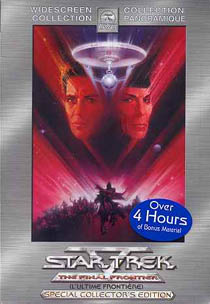
 The
Odd Ball
The
Odd Ball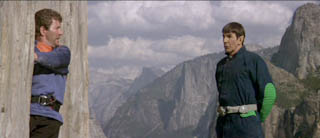 For anyone who has seen it,
this will be stating the most obvious, but Shatner, who also wrote the
piece, strayed way too far from the formula. Star Trek V tries to be
quite serious and in so doing is not really the fun movie we expect.
So they throw in some banal pieces which only serve to spoil it further:
Spock at the campfire, Scotty bumping into a bulkhead in Vaudeville style,
and Ohura doing an exotic dance on the sand dunes (did anyone else wonder
where the palms came from in that desolate place?)
For anyone who has seen it,
this will be stating the most obvious, but Shatner, who also wrote the
piece, strayed way too far from the formula. Star Trek V tries to be
quite serious and in so doing is not really the fun movie we expect.
So they throw in some banal pieces which only serve to spoil it further:
Spock at the campfire, Scotty bumping into a bulkhead in Vaudeville style,
and Ohura doing an exotic dance on the sand dunes (did anyone else wonder
where the palms came from in that desolate place?)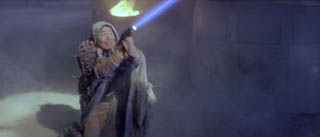 On the positive though, the
location shooting is actually quite good. Sybock's entrance is
reminiscent of Omar Sharif's in Laurence of Arabia. Maybe that
was an homage, since others abound: the "Paradise Lost" graffiti on the
entrance to the desert city, and if people are really listening, you can hear
the "beep-blop" from 2001: A Space Odyssey's pod when the Copernicus
Shuttle lands on the god planet. And finally an interesting
observation by yours truly: Star Trek V's three-breasted
alien exotic dancer is done as a more "R" version in Total
Recall just one year later. Humm . . . .
On the positive though, the
location shooting is actually quite good. Sybock's entrance is
reminiscent of Omar Sharif's in Laurence of Arabia. Maybe that
was an homage, since others abound: the "Paradise Lost" graffiti on the
entrance to the desert city, and if people are really listening, you can hear
the "beep-blop" from 2001: A Space Odyssey's pod when the Copernicus
Shuttle lands on the god planet. And finally an interesting
observation by yours truly: Star Trek V's three-breasted
alien exotic dancer is done as a more "R" version in Total
Recall just one year later. Humm . . . .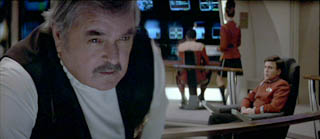 The Star Trek Universe
includes material not directly related to the making of the film, including A
Tribute to Herman Zimmerman, an interview with Shatner, A Green Future
which praises Star Trek's consistent vision of a positive future for our
world, Cosmic Thoughts which looks at religion and God versus the
cosmos and the Universe, and an interview with the
Todd Bryant and Spice Williams entitled That Klingon Couple.
The Star Trek Universe
includes material not directly related to the making of the film, including A
Tribute to Herman Zimmerman, an interview with Shatner, A Green Future
which praises Star Trek's consistent vision of a positive future for our
world, Cosmic Thoughts which looks at religion and God versus the
cosmos and the Universe, and an interview with the
Todd Bryant and Spice Williams entitled That Klingon Couple. We have to note that unlike the previous Star Trek
Special/Collector/Director's Editions, none of these extras are
16:9 formatted. Come on Paramount!
We have to note that unlike the previous Star Trek
Special/Collector/Director's Editions, none of these extras are
16:9 formatted. Come on Paramount!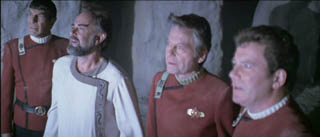 The Audio
The Audio

